The teaching in Leeds did not work out as I found myself very unsettled and unhappy in a place I did not want to be staying instead of being at home with Alison. There is always opportunity for me to work in Leeds again, but I do not want to be tied to regular delivery of FE baking courses there. I left at half term, and went on holiday to Sicily having already bagged an interview at Gateshead College for an Associate Lecturer post; that’s tomorrow!
Regarding baking, I have made the following breads at home recently:
1. Ciabatta
Wheat Levain built from stock wheat levain; no refreshment details available
Material/Stage | Formula [% of flour] | Recipe [grams] |
1. Wheat Levain |
|
|
Special CC Flour | 34 | 540 |
Water | 20.4 | 324 |
TOTAL | 54.4 | 864 |
|
|
|
2. Soaker |
|
|
Tumminia Flour | 18.9 | 300 |
Water | 47.2 | 750 |
TOTAL | 66.1 | 1050 |
|
|
|
3a. Final Dough - Bassinage |
|
|
Levain | 54.4 | 864 |
Soaker | 66.1 | 1050 |
Gilchesters Pizza Flour | 47.1 | 749 |
Salt | 1.76 | 28 |
3b. Water | 12.6 | 200 |
TOTAL | 181.96 | 2891 |
Overall % pre-fermented flour | 34 | - |
Overall % hydration | 80 | - |
Method:
- Build the leaven and set up the soaker in advance
- For the final dough combine the leaven and soaker with flour and salt for a., then mix the “bassinage” stage to develop the dough. Let the down with water as in b.
- Ferment in bulk for 3 hours with “S&F” every 50 minutes. Scale and divide as required. I made 3 trays of Foccaccia flavoured with Roasted Onions and Butternut Squash with Rosemary, as well as 3 loaves of Ciabatta.
- Shape the dough, then final proof for 3 hours. Bake in the wood-fired oven.
- Cool on wires.
2. Pain Siègle de Thezac.
Sour built from stock Rye Sour; no refreshment details available
Material/Stage | Formula [% of flour] | Recipe [grams] |
1. Rye Sour |
|
|
Bacheldre Dark Rye | 18 | 360 |
Water | 30 | 600 |
TOTAL | 48 | 960 |
|
|
|
2. Soaker |
|
|
Tumminia Flour | 10 | 200 |
Water | 38 | 760 |
TOTAL | 48 | 960 |
|
|
|
3. Final Dough |
|
|
Sourdough | 48 | 960 |
Soaker | 48 | 960 |
Special CC Flour/Marriages | 72 | 1440 |
Salt | 1.8 | 36 |
TOTAL | 169.8 | 3396 |
Overall % pre-fermented flour | 18 | - |
Overall % hydration | 68 | - |
Method:
- Build the sourdough and set up the soaker in advance
- Combine all the ingredients with soaker and sour for the final dough and mix to develop.
- Bulk proof time is 3¼ hours, with “S&F” every hour.
- Scale, divide and mould round. I made 3 loaves scaled at 650g and one large with the remaining dough at just less than 1450g
- Final proof for 3 hours in prepared Bannetons
- Tip out each loaf and score the top with an “S”, and bake in the wood-fired oven
- Cool on wires
3. Pane Nero di Castelvetrano with Almost-All-Sicilian Flour
Leaven Refreshment:
1. Monday 10:00 Wheat Levain Stock 20g [flour 12.5, water 7.5], “ODDO” Semola Rimacinato 50g, Water 50g.
2. Monday 15:30 Refreshment 1 above 120g [flour 62.5, water 57.5], “ODDO” Semola Rimacinato 137.5g, Water 62.5g
3. Monday 22:30 Refreshment 2 above 320g [flour 200, water 120], “ODDO” Semola Rimacinato 150g, Water 90g TOTAL 560g, as below, used at 06:00 Tuesday. Soaker: set up at 22:30 on Monday with refreshment 3.
Material/Stage | Formula [% of flour] | Recipe [grams] |
1. Wheat Levain |
|
|
“ODDO” Rimacinata | 25 | 350 |
Water | 15 | 210 |
TOTAL | 40 | 560 |
|
|
|
2. Soaker |
|
|
Tumminia Flour | 26 | 364 |
Gilchesters Organic Coarse Semolina | 3 | 42 |
Water | 35 | 490 |
Salt | 1.79 | 25 |
TOTAL | 64 | 896 |
|
|
|
3. Final Dough |
|
|
Levain | 40 | 560 |
Soaker | 64 | 896 |
“ODDO” Rimacinata | 46 | 644 |
Water | 18 | 252 |
TOTAL | 169.79 | 2377 |
Overall % pre-fermented flour | 25 | - |
Overall % hydration | 68 | - |
Method:
- Set up levain and soaker [see above timetable]
- Combine leaven and soaker with remaining flour and water and develop the dough, mixing by hand.
- Bulk proof for 3 hours with 1 “S&F” after 1½ hours.
- Scale and divide as 1 x 700g and 1 larger loaf of just over 1.5kg. Mould round.
- Final proof for 3 hours in prepared Bannetons.
- Bake in a pre-heated and hot electric oven using a baking stone and steam. I hadn't the time to chop wood for the brick oven today.
- Cool on wires.
I made the Ciabattas, Foccaccias and Pain de Siègles before we went away on holiday. A colleague in the village was looking after Shuffles [our cat] for a few days, and she had arranged a “Coffee Morning” on the Saturday to raise money to pay for fitting our new Christmas Lights in the village. Most of the breads were my contribution to that event. The bits leftover were for Beverley, my Sister-in-Law and my Niece, Eve, to tuck into when they stayed in our cottage the first weekend. We have enjoyed the last of the big Pain de Siègle loaf on our return from Sicily.
During the holiday, I quickly found a supply of Pane Nero di Castelvetrano, and took photographs to show what the modern day traditional and local version now looks like. The label is very revealing. “L’Antico Forno” means “The Old Bakery”, and it was situated in a smaller town just outside Castelvetrano. The ingredients are listed as Farina di Grano Duro, Aqua, Sale, Lievito. 30% of the flour is from the “Tumminia” durum. I do not have good enough grasp of the Italian language to know whether or not the loaf is made using Baker’s yeast only, or if an element of, or even all, natural leaven is used. From a flavour point of view, I would be inclined to think that Baker’s yeast was the chosen leavener.
However, the rest of the label gives more information to consider. The price of the bread was €3.00 per kilo, with each of the 3 loaves we bought being half kilo loaves. The date of manufacture is shown, and recommended consumption within 5 days. My two main comments: the keeping qualities were superb, and 5 days was a perfectly reasonable shelf life. So I really do wonder about the source of leavening! And, the taste of the bread had such a distinct sweetness to it, which Nico advised of when I first got hold of the Tumminia flour.
The day we went to Castelvetrano was a shocker; it rained heavily all day, so we were not tempted in any way to stop and seek out Molina del Ponti [see: http://www.molinidelponte.it/], the recommended milling source for a further supply of Tumminia. I did, however, locate some Durum flour in a local supermarket which had been grown in Sicily and milled in nearby Valderice. This is the link to the miller’s website: http://translate.google.co.uk/translate?hl=en&sl=it&u=http://www.molinooddo.it/prodotti.html&ei=sgiwTq-UL86-8gP88eW8AQ&sa=X&oi=translate&ct=result&resnum=1&ved=0CCAQ7gEwAA&prev=/search%3Fq%3DODDO%2Bgrano%26hl%3Den%26sa%3DX%26tbas%3D0%26biw%3D1132%26bih%3D448%26prmd%3Dimvns
I bought a 1kg bag of “Rimacinata” to use to make one more batch of Pane Nero di Castelvetrano, and I also bought a bag of the traditional Cous Cous which is very common in the north west of Sicily demonstrating an Arabic and African tradition.
My final formula for the loaves are given above, and plenty of photos to illustrate the whole post.
The sweet taste is there, and, a huge step forward here; Alison is raving about the crust on this bread! This is a new and very welcome event.
Happy Baking to you all!
Andy
- ananda's Blog
- Log in or register to post comments


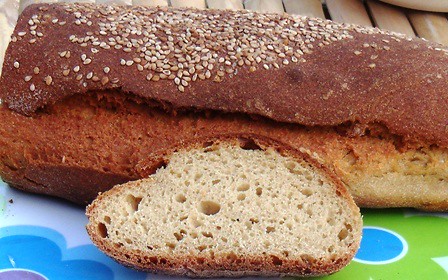


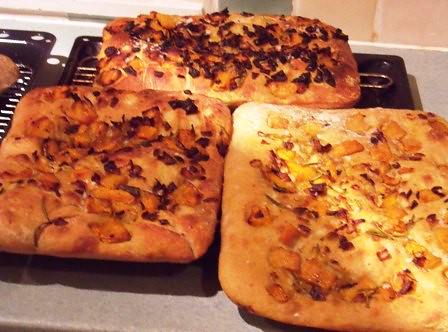
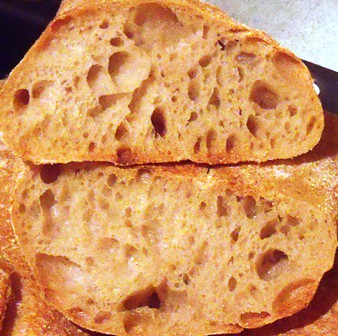


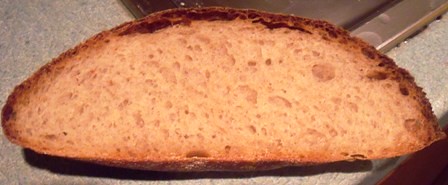
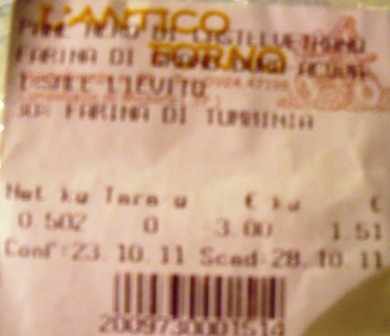
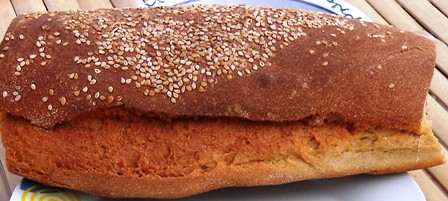
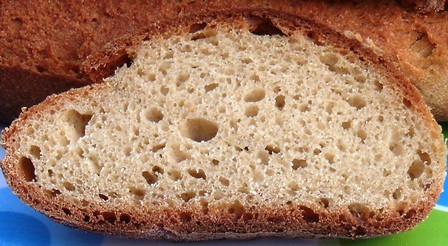





Hey Andy,
Good to hear you are on to other things. Leeds is a haul and being away from loved ones removes the fun from life. Good luck with the interview. I like that you use these exotic flours Andy. It sparks my creative curiosity to look for unusual ingredients here. We have access to some pretty interesting flours and you are reminding me to branch out and experiment.
Eric
Hi Eric,
Really good to hear from you; I gather we both took time away around the same time?!
Branching out is always a good idea. But latching onto really authentic ingredients is never as easy as it may seem. Doubtless, in terms of flour for bread, you have it all in abundance; but, as with good beer, which I know we both appreciate, you have to go the extra mile to find really special ingredients..and it is nearly always totally worth it too!
Very best wishes, and I so agree with your sentiment about where the fun in life is to be found...and NOT missed out on!
Andy
Nice post after a long absence. I'm sorry to hear that your work in Leeds is not what you have hoped (being away from a loving home it is an unbearable thought, from the beginning), and I wish you all the good luck tomorrow with your interview.
I'm impressed by the breads you show here today. I have a hot spot for durum lately and your breads got my attention imediatelly. I see you used a soaker in all the breads, and the soaker is made with tumminia flour. Can I ask why? Is it a certain particularity of this flour that requires to be soaked before using, or is there another reason? Maybe you explained it another time, and I missed it.
Those focaccia looks delicious, I did not knew that ciabatta and focaccia can be made from the same dough... can they? I also like the big Seigle loaf, that crust looks so full of flavor!
And... at last but not least, your "Pane Nero di Castelvetrano with Almost-All-Sicilian Flour" is superb. Good scoring, nice colour on the crust! If it tastes just as good as it looks, and I'm sure it does... you and Alison had some very qualitative breads on the table lately. My own latest experiences with semolina breads were so pleasant, that I can almost feel the sweetness of your loaf! I can only imagine that tumminia flour is way better than a regular durum flour...
Is good to see what you've baked lately. Good luck tomorrow and I hope for good news.
codruta
Hi Codruta,
So much to respond to in your generous comments; thank you so much.
I've managed to get work after the interview today, which is great.
Regarding the use of a soaker? No, it is not essential by any means, although there are benefits. The reasons I used this step are as follows:
1. Tumminia is milled as wholemeal, thus soaking allows for absorption of extra liquid.
2. Although high in protein, the gluten content and quality is not good. Lengthy hydration allows better gluten formation.
See Nico's comment here:
http://www.thefreshloaf.com/node/24641/tumminia-and-pane-nero-di-castelvetrano#comment-180844
It's not exactly known for strength and resilience. However, the flavour is really something unique. Actually, I genuinely believe it is the combination of tumminia at 30% with the remaining 70% as durum "Rimacinata" that gave such a great dough. I loved the look of the semolina dough in your post too!
Ciabatta dough is ideal to use for making foccacia. Now you have mastered "high rye", a Pain de Siegle should be an easy and welcome change!
Good bread on the table? This is the first time I have offered really good "crusty" bread and noticed Alison relishing eating it; a very welcome milestone!
So good to hear from you
Best wishes
Andy
What a pleasure to see one of your posts again Andy!
I realize it hasn't been that long since your last one but it seems that way, as I'm sure it does to more than a few other members of TFL. Being away from home and hearth has got to be a tough one for sure and I know I'd have the same difficulty with it as you found. I had to check where Gateshead College was in relation to you and it looks like a fairly short hop down the road from Powburn. Is it a commute that you can do by rail? I've no doubt you'll ace the interview and be passing on your baking knowledge to the students of the Gateshead College in short order, but best of luck regardless.
All your breads look splendid Andy, and I love the idea of roasted onions, butternut squash and rosemary as a Focaccia topping. Would you clarify if the second set of photos is of the Pain Siegle de Thezac? It's one I've been meaning to make for some time now and would like to use your photos as a reference point. Just want to be sure I'm referencing the right loaf. Very interesting about the 5 day shelf life of the Pane Nero di Castelvetrano you purchased. You wouldn't think a commercially yeasted bread would hold up that long lacking the acidity of a levain. I wonder if they've included some sort of preservative or acidifier to it that isn't evident or required on the label, or if it's a result of some other process used during fermentation that allows this extended shelf life. Whatever the case I'd much prefer to have your version on my table knowing it was made from the finest quality ingredients and with great skill. I'm a firm believer that the very best breads we can eat are the ones we make with own hands and bake in the traditional way. Your breads have always been a confirmation of that belief.
All the very best to you Andy,
Franko
Hi Franko,
I found it really hard to keep commenting regularly on TFL during my time in Leeds. Routine disruption caused havoc here; I wanted to comment on TFL posts, yet found it impossible to find time to set aside for it.....but that's over now!
Gateshead College is just across the river from Newcastle College, less than a mile away...so access by train just needs a short bus ride added on. That works for part time lecturing, and I'm glad to say I got the job.
Pain de Siegle is the second recipe/formula and set of photos; look for the "S"! There are quite a few entries for Pain de Siegle on my blog to checkout.
I firmly believe that the Pane Nero di Castelvetrano we found in Sicily was free from additives. I reckon that wise feloow Nico has is "sussed"....use of Pate Fermentee; that's the big secret!
For all that, I totally agree with your premise for bread put on the table; no surprise there then!
Very best wishes
Andy
Congratulations!! that's really good news...
congratulations on your new job! Glad to hear this good news.
ps. That cous-cous you mentioned.. is something special from other cous-cous you tried before?
codruta
Hi Codruta,
Link here for photos of the cous cous:
http://www.flickr.com/photos/24731237@N03/sets/72157628059190276/
It's a little less refined than some more industrial varieties I have used, and maybe smaller grain particle size.
It is most like the lovely Moroccan Barley Cous Cous which I like to buy from our local supermarket in Alnwick.
I definitely overdid it adding stock and heating it through fully! But it was a better attempt at a fish cous cous than we had in Trapani, for all that!
Best wishes
Andy
It would have been tough if you had loved the job in Leeds, and you still had the commute. I hope something closer to home and work that delights you comes your way.
The breads look great, as usual.
As it happens, the new edition of Carol Field's "The Italian Baker" which I'd pre-ordered months ago arrived today. I'm saving it for after dinner reading.
Best regards,
David
Hi David,
I don't own it, but Carol Field's book is reckoned to be a classic, and treausred by many bread afficionardos: happy reading!
My wood fired oven is less than a metre from the kitchen window; I hope that works out, of course!
You are right about Leeds; those possibilities did exist, yet I have no desire to re-locate to what is by far the largest city in Yorkshire; that was a fairly swift realisation leading to a relatively easy decision.
All good wishes
Andy
Welcome Home Andy,
I remember when my husband got transferred to St. Louis when we were engaged.....the separation was horrible and he was back within less than 6 months. He has never almost never looked back ( We have been married for 24 years now and have 3 kids - 2 of whom are teens.....) and he did land a job here when he returned. I do hope your interview goes well tomorrow and thanks for keeping us posted.
Your breads look lovely. Such a variety. You are so good at juggling a number of things....you were the one who inspired me to bake more than just one type of bread a day....now I can do 2 or 3 different ones but I find 3 is pushing it.....
Anyway, good luck tomorrow. :-)
Take Care,
Janet
Hi Janet,
I made the foccaccia/ciabatta and Pain de Siegle as one bake, with the Pane Nero di Castelvetrano as a separate bake. Ineeded both wood-fired and electric ovens for the first baking batch.
I love it where we live. Working away from home needs special skills, and I don't have them...or want them, either.
Many thanks for your comments and support
Best wishes
Andy
Nice to see back Andy ...
... and nice to see your wood-fired oven put to use in wonderful ways. They all look really great. Its funny reading all these posts about a the differing types of semolina flour available to you guys over there. I'm lucky to find even a stray bag of the stuff, usually full of weavels as its been sitting on a shelf so long :)
Anyway, all the best for your interview.
Cheers, Phil
Hi Phil,
many thanks for your generous comments; it is really good to hear from you.
It is a shame that you canot lay your hands on good durum flour. Australia is renowned as a producer of good quality Durum wheat for the Italian pasta production, I'm pretty certain. But, we are talking industrial flour on the global market here; I think I'd rather take the lovely wholgrains you describe using in your blog posts.
I'm confident that the 2 flours I used will be very different from durum wheats grown in the US.
All good wishes
Andy
Oh, I meant to ask... With your electric oven are you able to turn off the fan when it is baking? (ie for the first part of the bake when using steam) With the oven I am using this is not possible and I am still trying to achieve results I am happy with when not baking in dutch ovens. The crust on the Pane Nero di Castelvetrano does looks inviting.
cheers, Phil
Hi Phil,
My new SMEG oven has a knob with 8 settings on. Half of these use the fan assist, and half leave the fan switched off. The temperature can be adjusted all the way up to 280*C for the main oven settings too!
I bake the first 10 minutes without the fan using steam as needed. Then I switch over to the fan setting for the rest of the bake.
It's a great oven for a domestic version, although the grill setting is not so good, as it only works when the door is closed!
My previous oven did not allow me to switch the fan off either. To be fair, the most important factor is really how powerful and well-built your oven is in the first place. Given that I blew the last one up after several close shaves, you can imagine how happy I am to have this new and more reliable model in place! The brick oven on the patio is of course much more fun!
Best wishes
Andy
and I know that others here on TFL missed you and your precious knowledge, especially about rye!
Impressive breads, especially the all-durum one and the pain de siegle. I'm happy to read that you finally obtained the sweet note in the durum bread that distinguishes it from all the others. What do you think of the Oddo? How did the dough behave?
Traditionally sicilian breads were made only with old-dough. I'm sure that modern bakers use old-dough and baker's yeast to "save goat and cheese", to get the advantages of both ingredients :-)
I wish you the best of luck for your interview.
Hi Nico,
The combination of flavours from the Tumminia and ODDO flours was so fantastic; thank you for your wisdom! The ODDO flour was great, and I feel really privileged to have been able to make this loaf with such authentic ingredients given I live so far away from Sicily.
Using the equivalent of the French Pate Fermentee seems so obvious in hindsight! That explains so much.
So good to hear from you
BW
Andy
Good to hear from you, and shame (as others have said) re Leeds, but hey! You gave it a good go - fingers crossed for the other role...
What is this Tumminia flour anyway, and where is it from? I've recently got 3 bags of durum to play with (in London, there is a delicatessen that delivers, well, probably more than one, but at least I found one source!) and I love the taste it adds - will be trying out your Pane Nero soon...
take care, all the best
S x
Hi Sali,
It's really good to hear from you; are you coming to the UK TFL gathering in February?
The ODDO flour I bought will most likely be the closest to the durum you have sourced. It is durum flour classed as "Rimacinata", ie. re-milled. The ash content is listed at maximum 0.9% on the Company website here:
http://www.molinooddo.it/prodotti.html
I believe it could be sold as "Tipo 1", but maybe Nico can confirm that?
What was most important to me was that I tried to find flour as local as possible whilst in Sicily. The ODDO mill is in Valderice which was less than 30km from where we were staying. All the durum wheat they mill is grown to contract in Central Sicily. The Company have negotiated deals with a number of retail supermarket chains in Sicily which allows for an extensive, yet wholly local supply chain throughout......Are you reading this Messrs. TESCO, Sainsbury, ASDA, Morrisons? No I didn't think so
The "Tumminia" flour is much more specialist, and it is unlikely you could find it anywhere apart from in the Castelvetrano area. It is an old variety of durum wheat, milled to wholemeal. As Nico says, it is renowned for giving a wonderful sweet flavour, but its breadmaking qualities are very low; hence it is added at 30% of the grist. This was actually the last of the batch which Giuseppe brought back for me from his Sicilian work placement back at the end of July.
Yes, I got the job...and I start tomorrow!
All good wishes
Andy
I'm hoping (depending on work commitments) to persuade my other half to come along as well! (not necessarily for the bread part, but for the lunch!)
My durum is Gran Mugnaio - Molino Spadoni - Semola di Grano Duro - it doesn't mention re-milling or ash content, is designed for pasta and foccacia, protein content 12%; it's quite a fine flour. Details here http://www.molinospadoni.it/prod_cf_06.php (Google translate helps!) - says low ash but not a %age...
Thanks for teh info re Tumminia - I couldn't find much at all even googling! Oh well, may need a trip to Sicily some time (I've the latest Locatelli book which is Sicilian recipes - yum!)
Very pleased re the job - hope it goes spendidly!
S x
Hi Sali,
This is where you have to go for "tumminia" flour:
http://translate.google.co.uk/translate?hl=en&sl=it&u=http://www.molinidelponte.it/pagina.asp%3Fid%3D1&ei=W2iyTp69N5Ow8QP_l_3kBA&sa=X&oi=transl…
It was raining horribly when went to Castelvetrano, and it has to be said that the town is not an attractive one. Hence we did not stick around. We went on to Selinunte, nearby to visit the Greek temple remains as the weather began to clear: truly awesome sights!
Look forward to seeing you at the event then; Alison is also coming, but I will have to protect her from exposure to too much bread obsessing, no doubt!
Best wishes
Andy
Andy, 0.90 is closer to Tipo 2 than to Tipo 1, but in italy that classification applies only to soft wheat. Durum wheat is classified on granulometry, that makes more sense in my opinion.
Thanks Nico,
I agree with what you say about classifying durum by particle size, but thanks for clearing up how it would be classed in terms of the ash too.
Best wishes
Andy
- and disappointing experiences are also valuable - if you have a chance to do something different afterwards. Good luck for your new start, Andy,
Best wishes,
Karin
Hi Karin,
I try really hard not to "do" disappointment. But you are right that there is much learning for me to take from the experience at Leeds....as well as some interesting possible work partnerships down there too.
Actually I'm slowly beavering away at home using the oven and creasting a network of neighbours who will be sufficiently interested and commit to buying my home baked breads. Pretty much what you have done already, no?
Lovely to hear from you
Best wishes
Andy
Your Italian flour adventures are always a great read, Andy. The breads look fantastic! Congratulations and best of luck on your new educating adventure!
Marcus
Hi Marcus,
I think the Italian odyssey has reached a natural break for now. I'll probably be going back to the Gilchesters flours and hope to build up production here at home in the wood-fired oven. I had, however, thought about a pre-ordered Pizza Take Away service in the village one evening a week!
Thank you as always for your kind words
Best wishes
Andy
must be something special. The Pane Nero di Castelvetrano just looks awesome. So glad to hear you are doing well and making necessary changes in your work life. -Varda
Hi Varda,
I read that you were excluded from electronic communication of late. It's really good to hear from you, and thank you very much for your kind words
Best wishes
Andy
Yours bakes are amazing! I love the end of the formula...baked in a wood fired oven! Wow, and you chop your own wood too...I'd probably break something.
Nice to hear your finding new opportunities on the home front and the best to you and yours.
Sylvia
Hi Sylvia,
Yes, I was up late last night replying to posts. Looking at some of the typos above, it seems obvious I should maybe have gone to bed earlier, rather than forcing myself to stay awake in front of the pc!
The only wood I have for the oven just now is a couple of old pallets. They need to be broken up. I'm still working on regular supplies of wood, although I'm bound to thinking it will always be a case of whatever I have at the time.
Lovely to hear from you
Best wishes
Andy
Hello Andy,
How generous of you to bake these beautiful breads for your village fundraiser.
It was so interesting to read of your trip to Sicily - that you were able to taste the local Pane Nero di Castelvetrano, and find flour grown and milled nearby.
Congratulations to on your new job, and hope it brings much happiness to you, being closer to home and hearth!
:^) from breadsong
Hi breadsong,
Lovely to hear from you and thank you so much for all your kind words
Very best wishes
Andy